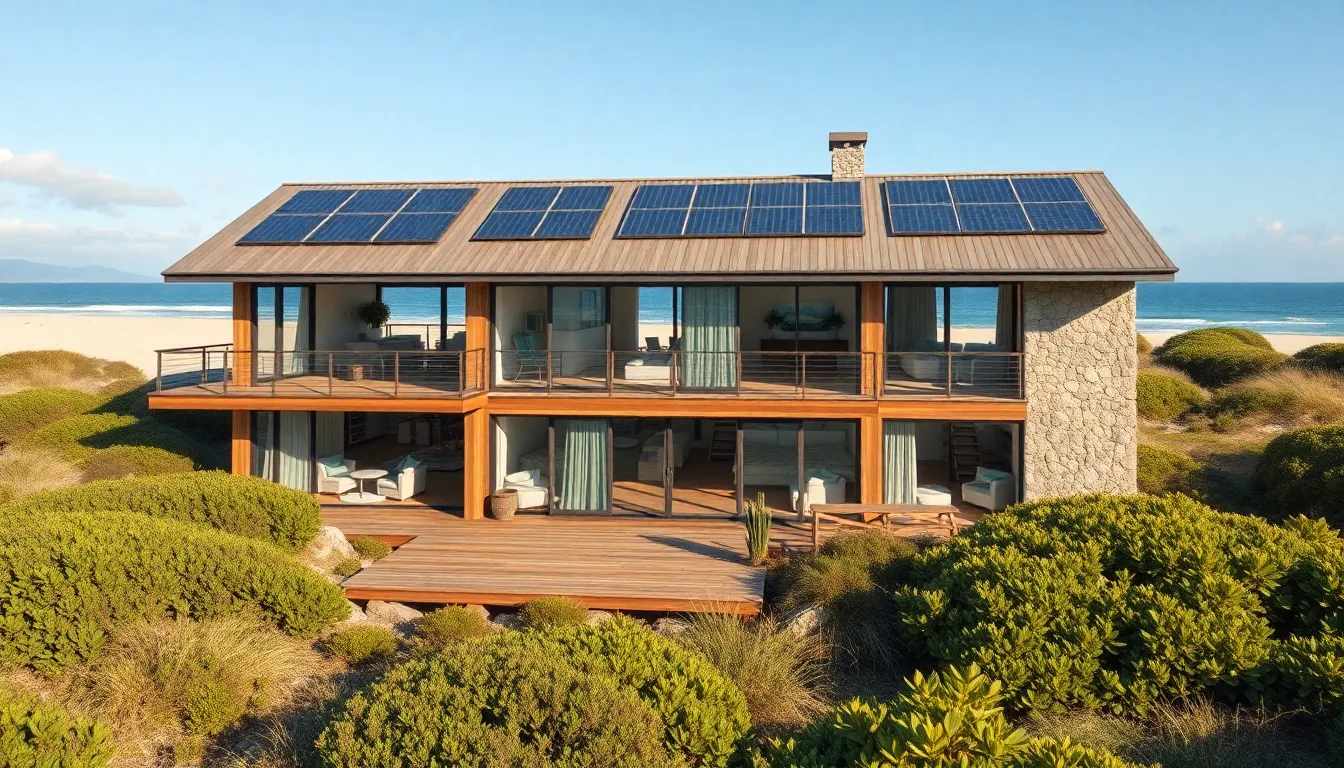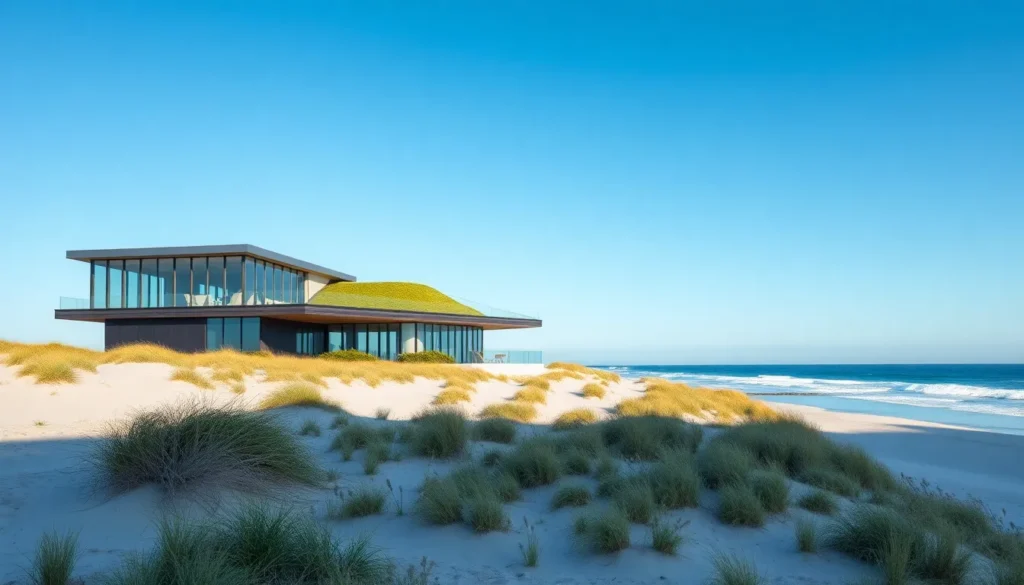Table of Contents
ToggleImagine waking up to the sound of waves crashing and the smell of salty air wafting through your window. Beach house architecture isn’t just about aesthetics; it’s the art of creating a sanctuary where the ocean meets comfort. From airy open layouts to sun-soaked decks, these homes are designed to embrace the coastal lifestyle while keeping the pesky sand out of your living room.
But let’s be honest—designing a beach house isn’t just about looking good in Instagram photos. It’s about crafting a space that withstands the elements, from hurricanes to seagull shenanigans. With clever use of materials and innovative designs, beach houses can be both stylish and functional. So grab your sunscreen and get ready to dive into the world of beach house architecture, where every detail counts and the ocean is always just a few steps away.
Overview of Beach House Architecture
Beach house architecture emphasizes a balance between visual aesthetics and practical functionality. These structures often feature open floor plans that maximize natural ventilation and light. Glass walls or large windows bring stunning views of the ocean inside, creating a seamless connection with the surroundings. Creating an inviting outdoor space with decks or patios enhances the coastal experience.
Selecting materials plays a crucial role in beach house design. Builders commonly use weather-resistant materials to withstand harsh environmental conditions, such as humidity and salt. Options like marine-grade stainless steel, treated wood, or concrete are popular choices for durability and longevity. Incorporating energy-efficient systems reduces environmental impact, making sustainability a key component.
Color schemes in beach houses often reflect the surrounding environment. Light, neutral tones mimic sandy beaches, while accents in blues or greens evoke the colors of sea and sky. These design choices contribute to a serene atmosphere, perfect for relaxation.
Landscaping complements beach house architecture. Native plants require less maintenance and enhance the ecological harmony of coastal living. Incorporating elements like sand dunes or rock gardens promotes natural beauty while protecting against coastal erosion.
Innovative design elements also provide functional benefits. Innovative roofs, such as those designed for rainwater collection, support sustainability efforts. Elevated structures prevent flood damage, meeting safety standards while maintaining aesthetic appeal.
Embracing modern technology integrates smart home features seamlessly. Automated systems manage lighting, climate control, and security, optimizing comfort and convenience. The combination of these elements creates a beach house that reflects modern living while remaining true to its natural setting.
Key Characteristics

Beach house architecture emphasizes aesthetic appeal and functional design, creating spaces that harmonize with coastal environments while ensuring resilience against natural elements.
Sustainable Design Elements
Sustainable elements play a critical role in beach house architecture. Energy-efficient systems significantly reduce overall energy consumption while solar panels often complement these features. Rainwater collection systems capture and recycle water for various household uses, minimizing water waste. Native landscaping not only enhances ecological harmony but also lowers maintenance requirements. Builders prioritize sustainable practices, optimizing resource use to create environmentally friendly homes.
Use of Natural Materials
Natural materials define beach house construction, enhancing both aesthetic and practical elements. Wood is commonly used for its warmth and ability to blend with the surroundings, while treated versions withstand saltwater exposure. Stone features often provide durability against harsh weather, ensuring structural integrity. Additionally, builders integrate materials like bamboo and recycled composites, promoting sustainability. The thoughtful selection of materials fosters a connection to nature, creating inviting living spaces that celebrate their coastal setting.
Famous Beach House Designs
Beach house designs manifest creativity and innovation across the globe, showcasing unique adaptations that blend with the coastal environment.
Iconic Architectures Around the World
Architects have crafted iconic beach houses that define coastal living. Casa Coastal, located in Mexico, features sweeping ocean views and open-air living spaces, blurring the line between indoor and outdoor areas. The Jinsha Beach House in China stands as an architectural marvel, utilizing cantilevered structures to offer stunning vistas while resisting coastal winds. Australia’s Palm Beach House integrates bamboo and stone, emphasizing sustainability and harmony with nature. Each design reflects regional characteristics, promoting a sense of place while prioritizing aesthetics and functionality.
Notable Designers and Their Contributions
Renowned designers have significantly influenced beach house architecture. Frank Lloyd Wright introduced organic architecture, harmonizing structures with their surroundings, exemplified in his designs along the coast. Richard Meier’s Sea House showcases minimalist designs with large glass walls that maximize ocean views and natural light. Alberto Kalach’s Casa Ventura uses local materials and respects the environment, demonstrating a commitment to sustainability. Each designer contributes distinct philosophies, creating captivating beach houses that resonate with the natural beauty of coastal landscapes.
Trends in Beach House Architecture
Beach house architecture continues to evolve, incorporating innovative design elements that enhance functionality and visual appeal.
Modern Aesthetic Innovations
A focus on sleek lines characterizes contemporary beach house designs. Colors often mimic natural surroundings, featuring muted shades paired with vibrant accents. Incorporating large sliding glass doors fosters a connection to the outdoors while maximizing natural light. Many homes now utilize green roofs, providing insulation and promoting sustainability. Smart home technology enhances efficiency, delivering convenience through automated systems like lighting and climate control. Unique architectural forms bring individuality to each property, creating standout residences along coastlines.
Integration with Landscape
Seamless integration with the landscape defines popular beach house designs. Structures often feature raised foundations, adapting to coastal topography and mitigating flood risks. Architects prioritize outdoor living spaces, enhancing the experience of coastal environments. Native plants play a crucial role in landscaping, requiring less water and providing habitat for local wildlife. The use of natural materials like stone and timber enhances harmony with the surroundings. Furthermore, panoramic views guide design choices, ensuring that every angle showcases the beauty of the coastline.
Beach house architecture beautifully marries aesthetics with functionality. It’s a testament to how design can enhance the coastal experience while ensuring resilience against nature’s challenges. As trends evolve toward sustainability and modern technology, these homes not only reflect their stunning surroundings but also promote eco-friendly living.
The integration of smart features and innovative materials demonstrates a commitment to both comfort and environmental stewardship. With a focus on open spaces and natural light, beach houses invite the beauty of the outdoors inside. Ultimately, they stand as enduring symbols of coastal living that inspire a harmonious relationship with nature.







